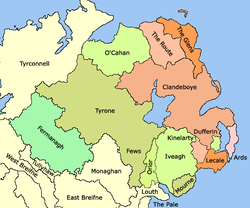Iveagh Uíbh Eachach (Irish) | |||||||||
|---|---|---|---|---|---|---|---|---|---|
| 4th century–1543 | |||||||||
 Iveagh in the 15th–16th centuries | |||||||||
| Status | Túatha of Ulster (until 1177) | ||||||||
| Common languages | Irish | ||||||||
| Government | Elective monarchy | ||||||||
| King / Chief | |||||||||
• died 552 | Fothad mac Conaille (first) | ||||||||
• 1543 | Art MacArtáin (last) | ||||||||
| History | |||||||||
• Established | 4th century | ||||||||
• Disestablished | 1543 | ||||||||
| |||||||||
| Today part of | United Kingdom of Great Britain and Northern Ireland | ||||||||
Iveagh (/ˈaɪveɪ/ EYE-vay; from Irish Uíbh Eachach, meaning 'descendants of Echu'[1]) is the name of several historical territorial divisions in what is now County Down, Northern Ireland. Originally it was a Gaelic Irish territory, ruled by the Uí Echach Cobo and part of the overkingdom of Ulaid. From the 12th century the Magennises (Mac Aonghusa) were chiefs of Iveagh. They were based at Rathfriland and were inaugurated at Knock Iveagh. Following the Nine Years' War, the rulers of Iveagh submitted to the English Crown and the territory was divided between them. Iveagh became a barony, which was later split into Iveagh Lower and Iveagh Upper. The territory of Iveagh was also the basis of the Roman Catholic Diocese of Dromore.
